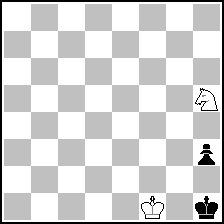|
| Page: [Previous] [Next] 1 2 |
| (21) Posted by Hauke Reddmann [Wednesday, Oct 17, 2007 11:14] |
As a computer buff, I could easily beat the record
by inventing some pieces (if I have to invent them at all)
that emulate a Turing machine. Then run a "n=5 Busy Beaver"
and you already need "tower notation" for the number
of moves :-)
Hauke
|
|
| (22) Posted by Geoff Foster [Thursday, Oct 18, 2007 04:45] |
Here is the ultimate length record.
 (= 2+2 ) (= 2+2 )
exact series helpmate in 2N+1
N can be any integer.
|
|
| (23) Posted by Hauke Reddmann [Thursday, Oct 18, 2007 13:16] |
Eh, Geoff, isn't the position automatically drawn after
a threefold position repeat when N is too large?
(I don't know the Codex on that issue)
Hauke
|
|
| (24) Posted by Geoff Foster [Friday, Oct 19, 2007 02:43] |
The Codex for Chess Composition states : "A position is considered as a draw if it can be proved that an identical position has occured three times in the proof game combined with the solution". So I have to admit (reluctantly) that Hauke is right and my masterpiece is busted.
However, I seem to recall that in a game of chess a player has to claim threefold repetition (there is no automatic draw). In my problem the two sides cooperate, so Black decides not to make the claim. In other words, I don't agree with the codex.
|
|
| (25) Posted by Ian Shanahan [Friday, Oct 19, 2007 04:44] |
Hi Everybody,
Just returning to the Rahmenschach idea... I think it may well be anticipated by something called "Edge Chess" that appeared in George Jelliss's "Chessics" many, many years ago. (Sorry, I'm in a public library, so can't access the details at present.) Also, a few years ago I had a New-Years-Greeting problem published in "The Problemist" that used a condition I called "Edgehog Chess" (after John Driver's invention, the Edgehog): i.e. all moves are either to or from the board-edge. Granted, this isn't the same thing as Rahmenschach - a partial anticipation perhaps?
@Geoff: I agree with your interpretation, invalidating 'draw by thrice repetition of position' in help-play, because, as you say, the draw isn't automatic, but must be claimed.
|
|
| (26) Posted by Kevin Begley [Friday, Oct 19, 2007 07:24] |
The claim about 3-fold repetition is of no concern.
The simple fact is, the problem is not a record.
While it may be there is an infinitely long solution, it is also true that there are an infinite number of solutions.
Nice try, but records are for problems with a finite number of solutions.
Kevin Begley.
|
|
| (27) Posted by Sarah Hornecker [Friday, Oct 19, 2007 10:17] |
@Mr. Shanahan
That's something else, it would be possible there to play e.g. Ra5->h5 which is not possible in Rahmenschach.
Imagine this:
wKd1 Re1 bKe8 Rd8
fully legal in Rahmenschach, but not in the one you talked about ;)
Yes, it may be a predecessor, I don't know. Only inventor Andreas Thoma could tell us (join here if you read this!)
|
|
| (28) Posted by Geoff Foster [Saturday, Oct 20, 2007 11:45] |
There is only one solution to my problem, for any given value of N. It is a series-helpmate in exactly (2N + 1) moves, which means that solutions in less than (2N + 1) moves are not permissible. Popeye only reports one solution for any given value of N.
|
|
| (29) Posted by Hauke Reddmann [Saturday, Oct 20, 2007 13:59] |
Addendum: Assume an 8x8 board and that the triple position rule holds
unconditionally. Clearly even with orthodox fairy conditions
or pieces (superb oxymoron, isn't it? :-), the number of positions
is finite: 64! if all pieces are different. So a chess problem
can last at much 64!*3 moves, and multiply that by 2 for any castling
or e.p. right than can get lost.
Metaproblem: Which fairy fairy pieces and conditions can
invalidate this number? An example:
Augsburger Schach. Pieces can change their identity.
Your move.
Hauke
|
|
No more posts |
Page: [Previous] [Next] 1 2
MatPlus.Net  Forum Forum  General General  Rahmenschach Rahmenschach |
 ISC 2024
ISC 2024 Forum
Forum  General
General  Rahmenschach
Rahmenschach 


